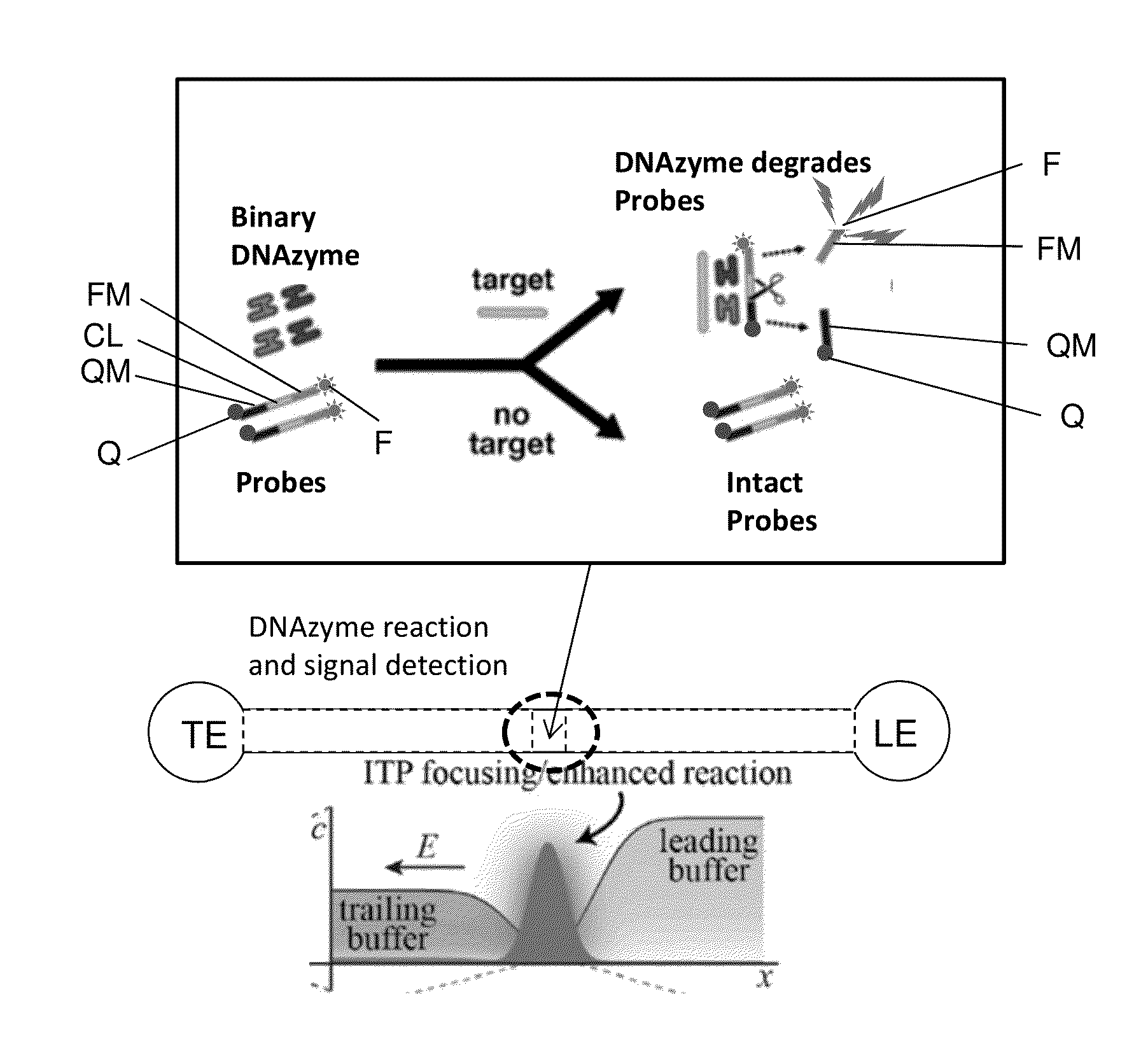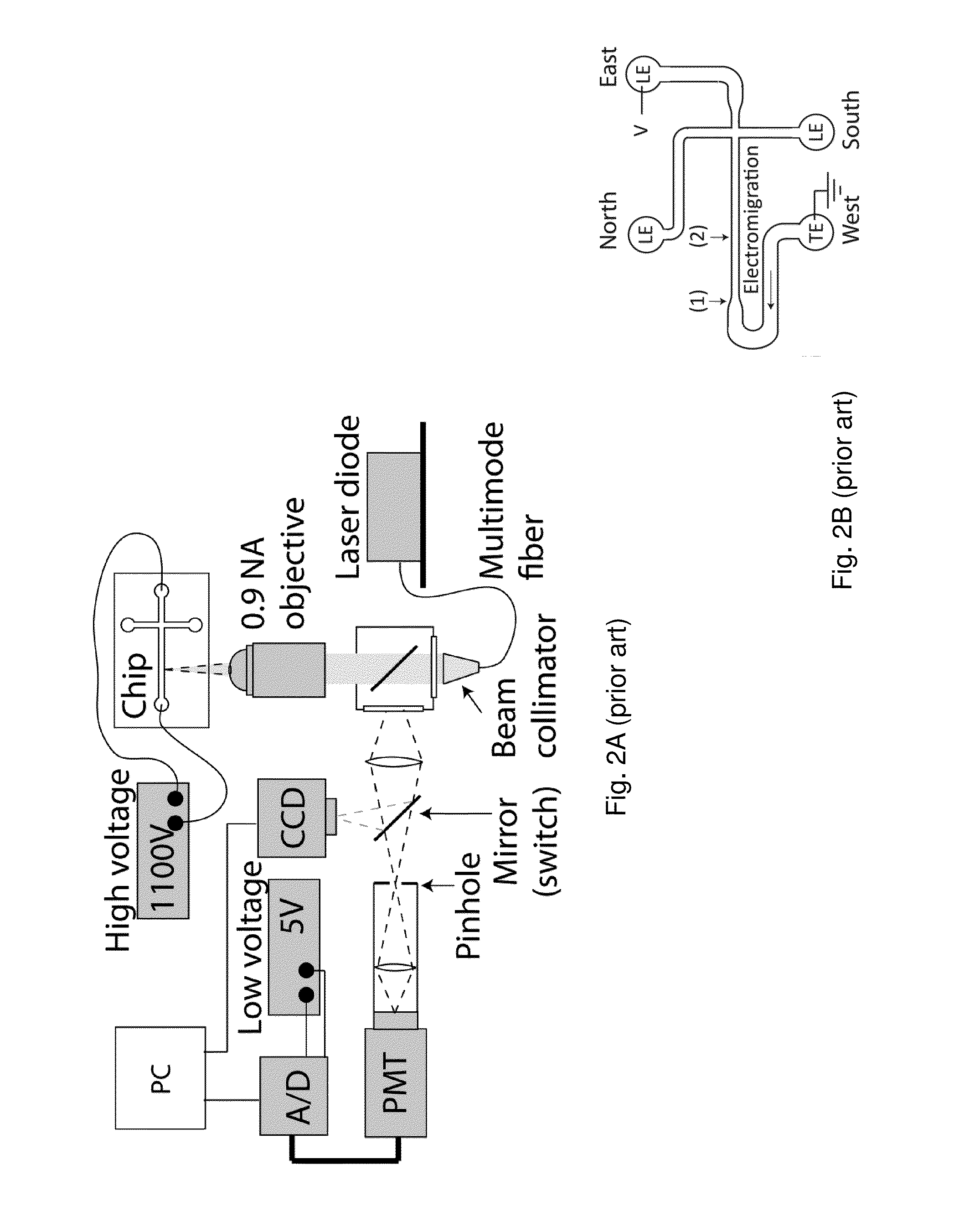Ultra-rapid and sensitive DNA detection using dnazyme and on-chip isotachophoresis
a dna detection and sensitive technology, applied in the field of dna detection, can solve the problems of low robustness, low specificity of detection, time-consuming, complex (low robustness) and expensive, etc., and achieve the effect of rapid and inexpensive dna detection techniques
- Summary
- Abstract
- Description
- Claims
- Application Information
AI Technical Summary
Benefits of technology
Problems solved by technology
Method used
Image
Examples
first embodiment
[0032]A first embodiment, shown in FIG. 6A, uses a binary DNAzyme and a probe, with simultaneous signal extraction. The binary DNAzyme (similar to the one shown in FIG. 5) has two parts; each part includes a target arm, a substrate arm, and a partial catalytic core. Initially in an inactive state where the two parts are separate, the binding of the respective target arms of the two parts to the target DNA forms the active binary DNAzyme structure, which can then hybridize to the probe and catalyze its cleavage. A FRET (Förster resonance energy transfer or fluorescence resonance energy transfer) quenching probe is used. The probe has three modules (see FIG. 6A): a quencher module QM modified by a quencher Q, a cleaved module CL capable of being cleaved by the binary DNAzyme activated by target sequences, and a fluorescent module FM modified by a fluorescent dye F. The cleaved module is located between the quencher module and the fluorescent module. The probe is capable of hybridizing...
second embodiment
[0037]A second embodiment, shown in FIG. 7A, uses a binary DNAzyme and a fluorescent probe with a probe capturing gel to accomplish separated signal extraction, where the location of signal extraction (detection) is separate from the location of the DNAzyme reaction. As shown in FIG. 7A, the probe has three modules: a capture module CAP capable of being captured by the capture gel, a cleaved module CL capable of being cleaved by the binary DNAzyme activated by target sequences, and a fluorescent module FM modified by a fluorescent dye F. The cleaved module is located between the capture module and the fluorescent module. The probe is capable of hybridizing to and being cleaved by the activated binary DNAzyme.
[0038]A sample containing target DNA sequences (or no target DNA sequence), the two DNAzyme subunits, and the probes are mixed, and the mixture is assayed using an on-chip ITP setup similar to that described in Garcia-Schwarz et al. Analytical Chemistry 2012 (see FIG. 3). Using ...
third embodiment
[0049]A third embodiment, shown in FIG. 8A, uses a binary DNAzyme and a fluorescent probe with a sieving matrix to accomplish separated signal extraction. The probe has three modules: a long module LM, a cleaved module CL capable of being cleaved by the binary DNAzyme activated by target sequences, and a short module SM modified by a fluorescent dye F. The cleaved module is located between the long module and the short module. The size difference between the intact probe and the short module is large enough to enable them to be separated by the sieving matrix in the microfluidic chip. The probe is capable of hybridizing to and being cleaved by the activated binary DNAzyme.
[0050]A sample containing target DNA sequences (or no target DNA sequence), the two DNAzyme subunits, and the probe are mixed, and the mixture is assayed using an on-chip ITP setup similar to that described in Eid et al. Analyst 2013. Using this setup, DNAzyme reaction takes place in the isotachophoresis condition,...
PUM
| Property | Measurement | Unit |
|---|---|---|
| reaction time | aaaaa | aaaaa |
| fluorescent | aaaaa | aaaaa |
| voltage | aaaaa | aaaaa |
Abstract
Description
Claims
Application Information
 Login to View More
Login to View More - R&D
- Intellectual Property
- Life Sciences
- Materials
- Tech Scout
- Unparalleled Data Quality
- Higher Quality Content
- 60% Fewer Hallucinations
Browse by: Latest US Patents, China's latest patents, Technical Efficacy Thesaurus, Application Domain, Technology Topic, Popular Technical Reports.
© 2025 PatSnap. All rights reserved.Legal|Privacy policy|Modern Slavery Act Transparency Statement|Sitemap|About US| Contact US: help@patsnap.com



